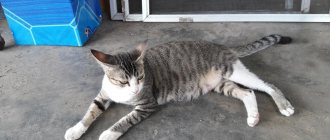What is otitis media, what can it be like?
This term refers to the inflammatory process in various structures of the ear.
There are many varieties of this disease. It is classified according to the factor that provoked its appearance, the speed of development and duration of the course, and the localization of the pathological process. Treatment and symptoms depend on the type of pathology. Depending on what caused the development of otitis, it is divided into the following types:
- allergic – occurs due to severe damage to the inner surface of the ear due to the reaction of the cat’s body to any allergen (pollen, food, dust, medications, etc.);
- bacterial and fungal - appears as a result of infection by bacteria and fungi, respectively;
- parasitic – caused by parasites.
According to the speed of development and duration of the course, otitis media is divided into:
- acute – the disease develops quickly and lasts from 5 to 14 days;
- chronic - arises from an acute form with improper treatment or its absence and is characterized by a long course with periodic exacerbations.
The last form of the disease is extremely dangerous. It can lead to many serious complications: hearing loss, paralysis of the facial nerves, development of ulcers, inflammation of the brain. The most dangerous consequence of the disease is the death of the animal.
Depending on which area of the hearing organ is affected by the inflammatory process, otitis media is classified into:
- Outer. This is the mildest form of the disease, which affects the external auditory canal and the auricle.
- Average. Inflammation of the middle ear, when the eardrum is involved in the pathological process. This form of pathology often becomes chronic.
- Labyrinthitis. Inflammation of the inner ear. This is the most severe and dangerous form of the disease. In addition to the eardrum, the vestibular apparatus is involved in the inflammatory process. Labyrinthitis is difficult to treat and more often than other types of otitis causes complications. Inflammation of the inner ear is fraught with damage to the membranes of the brain and the development of sepsis.
Dirty ears
Dirt in the ear can lead to inflammation.
A cat's sink may contain plant particles, leaves, wax plugs, and sand. This state of affairs most often leads to an inflammatory process .
Help consists of removing the foreign object, washing with a soda solution or hydrogen peroxide solution. The pain is relieved by instillation of camphor oil.
Common diseases affecting cats' ears
- hematoma;
- shell necrosis;
- lymphatic extravasate;
- internal and median otitis;
- otitis externa;
- presence of foreign objects;
- tumors.
The listed ailments are non-communicable diseases. Contagious diseases include otodectosis - the presence of ear mites.
Diseases affecting the ears of cats are non-contagious diseases.
Ear diseases in cats, regardless of the cause that caused them, are accompanied by similar symptoms.
The main ones are:
- Pain in the affected ear.
- Itching.
- Hearing impairment.
- The inner lining of the ear is hyperemic.
- Scratching, ulcers, and crusts appear on the outside of the ear.
- In a neglected state, when pressing in the ear area, the owner may hear a squelching sound.
All cats with ear lesions exhibit similar behavior.
Typical signs of ear damage in cats are:
- Characteristic head movements (the cat shakes its head as if water had gotten into its ear).
- The cat tilts its head towards the affected ear.
- The animal rubs its ear and meows pitifully.
- The cat actively scratches its ear, scratches it, and plunges its paw into the ear canal.
- The animal rubs its head on the floor or any objects.
- When trying to examine the sore ear, the cat withdraws its head and resists.
- When examining the pet's ear, the owner may notice an unpleasant odor from the auricle.
If the illness lasts for a long time, the animal may lose its appetite and develop a fever. The pet becomes irritable and nervous, and his sleep is disturbed. During sleep, the cat tries to sleep on its healthy ear.
Appears against the background of received bites from other animals or blows. A bruise forms if the vessels of the auricle rupture. In this case, the area begins to fill with blood. Due to the pressure, the auditory organ swells for a few minutes after the rupture, causing a feeling of discomfort.
If proper treatment is not started at the first symptoms, the neoplasm remains, and subsequently the accumulated fluid passes into the scar tissue phase. This phenomenon can externally irreversibly change the organ of hearing. The size of the tumor depends on the pressure and the level of compliance of the tissues located near it.
Treatment consists of removing the hematoma with a syringe or surgery. You cannot do this on your own! After opening the hematoma, the doctor will prescribe a course of antibiotic such as Ampicillin.
It has similar symptoms and occurs for the same reasons as a hematoma. The only difference is in the method of therapy. When you are sick, applying cold or heat is harmful. If lymph accumulates, the liquid is also withdrawn with a syringe. When the procedure does not give a positive result, surgery is necessary. During the operation, the doctor trims the hair, treats an area of skin with an antiseptic, then cuts the skin, removes the contents and finally applies stitches. After the operation, antibiotics are also prescribed for 3-4 days.
Belong to the most common ailment. The disease is also called otodectosis, which is characterized by brown “islands” on the inside of the ear. They are similar in appearance to coffee. The disease is caused by ticks, which can be easily seen. It is necessary to carry out treatment in a timely manner so that there is no inflammation and the animal does not die.
Otodectosis of the ears
When the disease is advanced, the animal becomes apathetic, body temperature rises, and pathological conditions of the nervous system—convulsions—occur.
Causes
The auricle of a healthy cat does not require special care from the owner. And if dirt appears in the ear, the animal may have serious ear damage.
Otodectosis
Ear scabies, called otodectosis in veterinary medicine, is one of the most common causes of ear diseases. Its causative agent is a microscopic mite. These parasites feed on the blood and lymph of the affected animal. To obtain food, they bite into the delicate tissue of the ear, causing serious discomfort to the animal. The main symptom of this disease is the formation of dark brown discharge in the cat's ears, reminiscent of coffee grounds with oil. These are waste products from the metabolism of hundreds of small parasites and clotted blood. Simply cleaning your ears will not solve the problem.
Otitis
The structure of a cat's ear is in many ways similar to the structure of the human auricle. And inflammatory processes, like in humans, can affect the outer, middle and inner ear.
Otitis externa is a serious disease caused by:
- sulfur plug;
- water getting into the ears;
- getting foreign objects into the ears;
- ear mites;
- hypothermia.
Signs of this disease are serous discharge from the ear with an unpleasant odor. The cat actively scratches its ear and shakes its head. In the absence of proper treatment, the inflammatory process can affect deeper structures.
Otitis of the middle ear, and especially the inner ear, is a dangerous disease for a cat, which if left untreated can lead not only to hearing loss in the pet, but also to its death. The causes of this disease are:
- tumors;
- ear and head injuries;
- coccal infection;
- ear mite damage;
- fungal infection.
This disease manifests itself as increased body temperature, ear pain, and loss of appetite. The animal presses the sore ear and does not allow anyone to touch it. The cat is irritable and does not sleep well.
Abscess
An injury or wound, even a small one, can become an entry point for pathogenic microflora. Pus forms at the site of inflammation. The cat’s body temperature may be elevated, the animal loses its appetite, and its general condition is impaired. The affected area is swollen and painful. The cat scratches and rubs its ears and meows pitifully.
Dermatitis
Hyperemia of the auricle, rashes, focal alopecia, scratching - all these are signs of dermatitis. This is caused by food allergies or contact with irritating chemicals.
Hematoma
Pain in the ear area in an animal can be caused by trauma that leads to hemorrhage in the tissue of the ear. The cat does not allow you to touch the sore spot and presses its ear to its head. If left untreated, such hemorrhage can lead to ear deformation. Injured tissue may become abscessed or necrotic.
Ulcerations
Blisters with serous or serous-purulent contents may appear on the animal's ear; the blisters open and ulcerate. The affected areas are very itchy. Typically, erosions and ulcers are accompanied by fungal infections.
Diagnostics
To begin, your veterinarian will examine the outer ears, noting any signs of inflammation, injury, swelling, discharge, or excessive wax. Then he will use an otoscope to check whether the passage and eardrums are clogged. If an infection is suspected, tests will be performed on samples of fluids or discharge from the ear.
Important! In complex cases, neurological and electronic tests, x-rays, computed tomography (CT), and magnetic resonance imaging (MRI) may be required.
Kidney disease in cats: symptoms and treatment
Description of drugs against ear mites
Today, the modern market provides us with a huge selection of drugs, both domestic and foreign. In order to get rid of the parasite, you can use drops, gels, ointments, aerosols, and spray. Medicines can be purchased at any veterinary pharmacy.
Let's look at the most effective drugs:
- Surolan. These are medicated drops that are effective in treating dermatitis, otitis media and ear mites. Active ingredients: miconazole nitrate (kills gram-positive bacteria), prednisolone acetate (kills gram-negative bacteria) and glucocorticoid acetate (relieves itching and inflammation). Use 5 drops in both ears once a day. There are no side effects.
- Amitrazine. The composition and release form are indicated in the instructions. The drug is produced in the form of drops, which have a detrimental effect on parasites. The composition includes amitrazine and decamethoksin, as well as additional active substances. They help faster tissue regeneration after scratching, relieve itching and pain. Drop 0.5 ml into each ear daily using a pipette. Seven procedures will be enough.
- Amidel-gel. The active ingredient is amitraz. It is this substance that blocks the nervous system of arthropods, causing tremors and then the death of the parasite. Lidocaine hydrochloride relieves inflammation and itching. Methyluracil accelerates healing and stimulates the body's defense at the cellular level. The gel is applied in a thin layer to the inner ear (previously cleaned) and rubbed in with massage movements.
- Aversectin ointment. The active component is aversectin C. It fights not only larvae, but also adult parasites. The drug disrupts the functioning of the nervous system, the tick is immobilized and dies. Apply a thin layer daily. Direct massage movements of your fingers from the edges to the center. For complete cure, 3-4 treatments are enough. This ointment should not be used with any other antiparasitic agent.
- Aurikan. These are bactericidal ear drops for animals. Available in 25 ml bottles. Active ingredients: tetracaine chloride, hexamidine diisethionate, prednisolone and diazinon. You need to instill 5-6 drops into each ear daily. Thanks to the bactericidal agent, steroidal anti-inflammatory and antiparasitic components, arthropods die along with the larvae within 5-7 days of using the medicine.
- Stronghold. Release form: odorless and colorless drops. It is worth noting a very convenient bottle that will allow you to measure the required amount of medicine and comfortably apply it to the affected skin. The active component is selamectin. It is he who poses a mortal threat to all arthropods. Can also be used for small kittens from 1.5 months of age. The drops affect the parasite's nervous system, blocking nerve impulses. The muscle fibers are paralyzed, and the arthropods quickly die.
- Frontline. The medicine ensures the rapid death of parasites. Frontline for cats guarantees quick results. 5 drops are placed in each ear. There are 3 types of the drug: Spot On, Combo and Spray. For ear mites and for their prevention, it is recommended to use Frontline Combo. Available in the form of drops for external use. Ticks die within two days of use.
- Leopard. This is an effective remedy for arthropods. The medicine is famous for its acaricidal effect against larvae and adults. The procedure is carried out once every 5 days. Place 5 drops in the animal's ear. Leopard relieves itching, inflammation and stimulates the healing of wounds and scratches.
- Anandin Plus. Drops have antimicrobial and anti-inflammatory effects. The medicine is transparent (slightly yellowish) and has a specific odor. Contains the synthetic pyrethroid permethrin, as well as additional active substances that help combat itching and inflammation. You need to instill 3-4 drops into each ear. It is enough to carry out two procedures with a five-day interval.
Prevention of ear inflammatory diseases in cats
Following the rules of its maintenance and care will help maintain the health of your furry creature:
- Periodically carrying out activities for decontamination and disinfection of the animal’s habitat.
- Preventing contact with outdoor cats who are ready to “share” ticks and fleas with their pets.
- Regulation of the microclimate in the room where the meowing companion is kept: bringing humidity and temperature to normal, eliminating cross-ventilation.
- Timely removal of wax and dirt from the ears and entrances to the ear canals. It is advisable to carry out this procedure at least once a month.
- Protecting the purring organs of hearing from water during bathing sessions.
- Providing a nutritious diet and vaccination are the most important conditions for the formation of strong immunity.
- Visit the veterinary clinic for preventive purposes and at the first occurrence of alarming symptoms.
Remember: untreated otitis will remind itself more than once with returns and complications. Don’t risk the health of your four-legged friend: don’t let ear pathology take its course, don’t trust “healers” without medical education. Rely on the knowledge and experience of a veterinarian - and your pet will be healthy from tail to ears.
To avoid having to treat your pet for a long time and not always successfully for these insidious diseases, it is necessary to take measures to prevent its development, namely:
- do not allow the animal to become hypothermic;
- feed your cat correctly;
- regularly inspect your cat's ears for parasites;
- exclude contact with stray animals while walking;
- properly care for your cat’s ears and prevent water from getting into them while bathing;
- keep your pet clean;
- Conduct regular preventive veterinary examinations.
Share with friends!
Prevention of ear problems includes cleaning with substances prescribed by your veterinarian. This type of cleaning must be carried out continuously. Do not forget that the process of cleaning the ears should not cause pain to the animal. The entire procedure is done carefully so as not to injure the cat’s hearing organs. To avoid any unpleasant moments, you need to know what the prevention of ear disease in cats is. To clean your ears you need to:
- prepare tools, substances;
- will make sure that the cat is calm and not alarmed;
- wrap the animal in a towel to protect yourself from scratching with claws;
- It is necessary to drop a substance or lotion into the ear;
- after instillation, you should not pinch your ear too much and make massaging movements;
- After this manipulation, you can take a cotton swab and remove excess liquid.
When the treatment and cleaning of the ear is done correctly, the cat owner does not need to worry that the pet may develop complications. Teach your animal from childhood to constant ear examinations. Do this delicately, combining it with gentle stroking.
It is periodically necessary to carry out the prevention of ear diseases.
Ear washing lotions - “Otifri” and “Epi-otik”, as well as “Bars” lotion, in addition, 2 products of the German company Beaphar - can be obtained at any veterinary store. An interesting solution is the “Miss Kiss” sticks - these are ordinary sticks soaked in a medicinal agent.
Video “How to clean the ears of a cat and dog”
To prevent the consequences, as in the photo, of the formation of plugs and mites, watch the video for the correct process of cleaning cats’ ears.
Was this article helpful?
Thank you for your opinion!
The article was useful. Please share the information with your friends.
Yes
No (100.00%)
X
Please write what is wrong and leave recommendations on the article
Cancel reply
Rate the benefit of the article: Rate the author ( 7 votes, average: 3.71 out of 5)
Discuss the article:
Bacterial otitis: causes, symptoms and treatment
Microbial otitis is secondary in almost all cases. They develop due to hypothermia, water getting into the pet’s ears, damage to the inner surface of the hearing organs, for example, due to improper cleaning with cotton swabs.
The inflammatory process may involve one or both ears. The disease is accompanied by:
- unbearable itching;
- discharge of dirty yellow purulent exudate;
- redness;
- an unpleasant odor that appears due to the fact that the ears are festering.
A sick kitten or adult animal becomes lethargic, apathetic, refuses to eat, and sleeps poorly due to the fact that its ears hurt and constantly itch. Microbial otitis media is treated with antibacterial drugs in the form of injections. Typically, four-legged patients are prescribed penicillins and cephalosporins. The course of antibiotic therapy is 7 days, even if the symptoms of inflammation disappear earlier.
To eliminate itching and pain, ear drops (Otibiovin, Otonazole, Aurikan) are used. To properly instill them at home, you must carefully study the instructions for use. For severe scratching, wound healing ointments (Levomekol, Iruksovetin) are used. If there is heavy purulent discharge, the ear should be washed at the veterinary clinic. If a blockage of the ear canal is detected, the help of a surgeon is sought.
Otodectosis
Perhaps the most common invasion is otodectosis. The causative agent is a microscopic mite.
The causative agent of otodectosis is a microscopic mite.
- The transmission route is mainly contact.
- Symptoms are typical for all parasitic diseases.
- The animal is restless and constantly itches.
- Brownish discharge is observed from the ears.
- Treatment consists of daily cleaning of the sore spot and instillation of drops, for example, tsipam.
- The course of treatment is seven days.
- If it does not give the desired effect, it is allowed to drip in two drops of stronghold after thorough cleaning.
- Repeat in about a month.
Characteristic symptoms
Ear diseases in cats are manifested primarily by changes in behavior. You should watch your pet and if this happens constantly, then something is wrong with the animal:
- constantly tilts his head to the side;
- shakes his head;
- twitches his ears sharply, as if they were splashed with water;
- often and suddenly rubs the ear with a paw;
- presses his head against upholstered furniture, against the carpet;
- does not allow ears to be touched, runs away when the head is stroked;
- scratches the ears often and strongly, resulting in bruising;
- loses orientation in space, when walking the cat is constantly pulled to the side.
If this behavior is noticed in your pet, you should carefully examine the inside of the ears. There may be redness and ulcers in the ears, light or dark discharge, dirt in the form of dark crumbs, bloating and swelling. The diseased ear may smell unpleasant, and when you lightly press on its base, a sound similar to squelching can be heard.
Changes can occur in one or two ears at once.
If you notice that your cat’s ear itches or hurts, and she is worried, and any discharge or changes inside the auricle are detected, then the question arises - what to do and how to treat. There are many ointments, drops and lotions, but they cannot be used without clarifying the diagnosis. If they can cure one disease, then in another case they can cause harm and waste time.
Otitis
The symptoms of otitis are in many ways similar to many ear diseases.
With otitis media, ear discharge and redness are observed.
The pet's behavior changes, the cat becomes restless and aggressive, ear discharge, redness and swelling of the diseased organ are observed. There may be an unpleasant odor coming from the sink. In more complex cases, appetite disappears and the temperature rises.
Treatment
At the beginning of treatment, clean the affected area with a cotton swab.
Treatment is carried out in a complex: local treatment and drug therapy.
- First of all, clean the affected area with a cotton swab dipped in a solution of boric acid, hydrogen peroxide or furatsilin.
- Dry with a cloth.
- Use ear drops.
- It is possible to relieve pain with novocaine blockade.
- A course of antibiotic therapy and medications that support the general condition of the animal are prescribed - immunostimulants, vitamins.
- At the same time, they provide the cat with a complete diet with vitamin and mineral supplements.
Allergic otitis: signs and therapy
Allergic otitis Ear inflammation in a cat can be initiated by an allergic reaction. It is wrong to think that with allergies, a pet only sniffles, tears flow profusely and sneezes often. The ears are often involved in this process. When mast cells release histamine into the blood, vascular permeability increases, which can lead to changes in the natural microflora of the ear canal.
A sick pet constantly scratches its ears, which causes scratches and sores to appear on them, and hair falls out. Ignoring these symptoms can lead to the development of a secondary infection, in which the cat begins to secrete exudate from the ear canals. At first it may be serous fluid, but over time pus or dead tissue will appear. At the same time, the animal’s muzzle will swell.
You should not try to cure your four-legged pet yourself at home. Before taking action, it is necessary to find out what exactly caused the development of the inflammatory process. This can only be done in a veterinary clinic.
If a four-legged patient is diagnosed with otitis media of allergic etiology, he will be prescribed glucocorticoids (Prednisolone), antifungal and (or) antimicrobial drugs. Antibiotics are used because non-steroidal anti-inflammatory drugs, while stopping allergic reactions, greatly reduce immunity, which is fraught with secondary bacterial or fungal infection.
My cat has ear pain, what should I do?
First you need to examine your ear!
Mechanical damage to the shell, such as injuries, bruises, bites and scratching, provokes the appearance of a hematoma.
- As a rule, compaction develops on the inside and very rarely on the outside. Characterized by swelling and sagging.
- A significant swelling may form, which is hyperemic, painful and hot to the touch.
- Prolonged ignoring of symptoms provokes the development of secondary pathology and serious complications, which can result in cartilage necrosis.
- The animal's behavior also changes: the pet makes sudden movements of its head, constantly rubs the affected area with its paws or scratches.
- Shows nervousness and aggression.
Scratching provokes the appearance of a hematoma.
Treatment at home
Treatment consists of applying a fixing bandage.
Treatment consists of using a fixing bandage and applying ice. After a day, you can use warm compresses and local treatment with irritating ointments. Advanced cases require surgical opening of the hematoma, cleaning and disinfection. It is recommended to use novocaine with an antibiotic to prevent further development of pathogenic microflora.
Preventive measures
The best way to prevent a painful ear infection is to have your pet checked and examined regularly.
Tips for a cat owner:
- Minimize the amount of time your cat (especially if she is white or lightly pigmented) is exposed to direct sunlight, for example by sitting in a window.
- Keeping the area clean will help prevent the spread of ear mites and other potentially infectious agents.
- Check your pet regularly for infections, swelling, and discharge.
- Consult a veterinarian when the first symptoms of the disease appear.
Fortunately, ear diseases in cats are easy to treat with proper diagnosis and prompt treatment. It’s worth asking your veterinarian to show you exactly how to check and clean your four-legged friend’s ears. Healthy ears are pale pink, with no visible debris or odor, with minimal or no ear wax. Keeping your skin dry will help prevent infections.
The best way to prevent a painful ear infection is to have your pet checked and examined regularly.
Symptoms of ear diseases
Whatever the disease, the animal always shows some symptoms with which the doctor can make a diagnosis. Therefore, when it comes to ear diseases, veterinarians identify several main signs of illness.
- Tilt of the head to the side.
- The pet regularly tries to scratch its ears because it is tormented.
- The cat is apathetic.
- Any ear disease is characterized by discharge from the auditory organs.
- The pet often presses its ears to its head.
- The temperature rises.
- The auricle is red, and fluid accumulation may be noticeable on its surface.
Symptoms of ear diseases in cats
The main thing at the first changes in the cat’s well-being is to visit a veterinarian, who can immediately identify the cause and prescribe competent therapy.
Otodectosis and parasitic otitis media
Otitis of parasitic etiology is more common in kittens than in adult cats. A sick pet experiences unbearable itching, trying to relieve it, he constantly shakes his head and scratches his ears, which often leads to the appearance of bleeding wounds on them - a gateway for pathogenic microorganisms. When examining the ear canals, you can find dark brown discharge of a crumbly consistency in them (see photo). This is nothing more than the waste products of the parasitic mite Otodectes cynotis.
Signs of an ear mite
Once in the ear canal, the parasites feed on epidermal cells and actively multiply. If there are too many of them, they move from the auricle to the scalp. Pests lead to increased sulfur production. Mechanical irritation of the skin and allergies to waste products provoke the development of an inflammatory process in the external auditory canal.
When in contact with a sick pet, personal safety precautions must be observed. Otodectes cynotis does not live on human skin, but can cause allergies.
Treatment of the disease is aimed at eliminating parasites and concomitant bacterial or fungal infection, if there are signs of it. You should not thoughtlessly use drops with an anti-tick effect, especially if there is a violation of the integrity of the eardrum. A veterinarian must prescribe medications.
Treatment
If you have otodectosis, you need to clean your ears every day from mite waste products and drip special drops into the ear canal to treat this disease (Tsipam or any other). You need to drip into both ears, regardless of the fact that one of them may appear unaffected. If this does not help, you need to urgently take your pet to the veterinarian. It is even better to do this before starting treatment to make the correct diagnosis.
If the cat is actively itching and injures the ear, you need to put on a special collar (often called “Elizabethan” because of its shape) and take it to a specialist. In case of traumatic injuries, the animal requires mandatory assistance from a veterinarian. For open wounds, you need to apply a sterile pressure bandage to stop the bleeding, then take your pet to the hospital.
Abscesses require surgery. Unfortunately, if pus has formed in the tissues, it is not prone to spontaneous resorption. Surgery will be required.
Common diseases affecting cats' ears
Cat diseases: symptoms, table, treatment
If the ear is sore, the animal will show discomfort by scratching or pawing at it, shaking or tilting its head towards the painful area.
Other manifestations of ear disease in cats:
- black or yellowish discharge;
- redness or swelling of the ear or ear canal;
- waxing on or near the ear canal;
- bubbles;
- strong smell;
- hearing loss;
- loss of balance or disorientation.
The main symptoms of all ear diseases
Each disease has its own specific symptoms, most of which can be seen in the photo. However, there is a certain set of standard manifestations of ear diseases. If you notice any of the following, contact your veterinarian.
So, the following symptoms can signal that not everything is all right with your animal:
- bowing the head to one side;
- itching in the ears, the animal scratches its ears with its paw;
- apathy;
- discharge;
- pressing the ears to the head;
- heat;
- external manifestations in the form of tumors, bumps and wounds.
The health of your cat is in your hands. Pay attention to any manifestations! Don't delay visiting the veterinarian - this way you can avoid serious consequences!
Fungal infection of the ear
Otitis of fungal etiology, or otomycosis, is an inflammation of the hearing organ, provoked by pathogenic or conditionally pathogenic fungi. Often this disease develops against the background of bacterial infections or ticks. The disease can be identified by unbearable itching, pain and redness. The inside of the diseased ear is almost completely covered with waste products of fungi. They look like greenish-gray cotton wool. The blockage often leads to hearing loss. Pus is released extremely rarely.
Folk remedies for ear mites in cats
In addition to traditional treatment, there is also folk treatment, which contains natural ingredients with a healing effect. Treatment with folk remedies will help lead to the death of the ear parasite, relieve itching and inflammation. The most effective methods are listed below.
Mineral oil
Mineral oil is an excellent home remedy for cats. It helps not only to dissolve ear discharge, but also to kill ear mites. Using mineral oil for two to three weeks will eliminate the parasite. Use enough to coat the inner ear with oil. In order for the arthropods to come out, 4-5 days of effective treatment must pass.
Olive oil
Olive oil is an excellent remedy for ear mites in cats. It can be used alone or with other ingredients to enhance its effectiveness. Should be used as a natural remedy for ticks:
- heat the olive oil in a water bath;
- place the cat on your lap and pet it to relax;
- using a syringe or pipette, place a couple of drops of oil into the ear canal;
- Perform the massage in a circular motion.
After the procedure, the animal will most likely shake its head. This will remove debris from the ear canal. Clean the outside with a towel or cotton swab and treat your pet to something tasty.
White vinegar
White vinegar helps in killing parasites by balancing the pH levels in the ears. This method cannot be used on cats that have wounds on the ears.
- mix one part vinegar with an equal part water;
- Using a pipette, place a few drops of the product into each ear.
After the procedure, use a cotton pad to wipe the inside of your ears.
Honey
Beekeeping products have long been famous for their unique qualities. Honey is known to have antiseptic properties.
Let's start treatment:
- mix equal portions of water and honey in a bowl;
- Using a pipette, inject the resulting mixture into the ear canal (5 drops are enough).
The procedure should be repeated until the ears become clean and healthy.
Green tea
As a natural antiseptic, green tea will help eliminate germs and debris in your cat's ears. The product is easy to use and gives results within a short time.
Rules of use:
- brew cool green tea;
- strain and let the drink cool before using;
- moisten a cotton pad (do not squeeze too hard) and wipe the affected skin thoroughly.
It is recommended to carry out a similar procedure every day for a month.
The best way to get rid of ear mites is to choose a treatment option and be consistent in using it. The result will depend on your persistence and regularity of procedures. If the chosen drug does not help after 2-3 weeks, you should choose another remedy. Remember to always clean your cat's ears to avoid re-infection.
Inflammation and perforation of the eardrum: symptoms and treatment
Chronic otitis media can lead to perforation of the eardrum and the development of an inflammatory process in the deep layers of the ear. Symptoms depend on the extent of damage to the septum and whether the inner ear is affected. You can distinguish this problem from others by the following signs:
- the pet often shakes its head and tilts it towards the organ that hurts;
- the animal is poorly oriented in space, walks in circles;
- the affected ear becomes red and swollen, and foul-smelling exudate is released;
- the cat hears poorly, becomes lethargic, refuses food;
- The cat has Horner's syndrome, in which the upper eyelid droops, the pupil narrows, and the eyeball sinks.
The veterinarian begins treatment only after making an accurate diagnosis. Diagnosis includes a visual examination of the affected organ, otoscopy, x-rays, and in some cases CT and MRI. Four-legged patients are usually prescribed antibacterial and antifungal drugs to relieve inflammation in the organ of hearing, and systemic corticosteroids. If the membrane is slightly damaged, it recovers quickly. In more severe situations, surgical intervention is resorted to.
Anatomy of the ears of cats and cats
The ear is the organ of hearing and balance. It consists of outer, middle and inner.
The outer ear includes the pinna (the visible part of cartilage covered by skin, fur, or hair) and the ear canal. The ear canals of cats and kittens are deeper and more conical than those of humans. This deeper canal is prone to the accumulation of dirt and wax, leading to inflammation and secondary infections.
Cats' hearing is many times more sensitive than humans'.
The middle consists of the eardrum and an air-filled chamber that contains 3 tiny bones, 2 muscles, the oval window and the eustachian tube.
The inner ear is a complex structure that includes the cochlea (the organ of hearing) and the vestibular system (the organ of balance).
Anatomy of a cat's ear
Ear diseases and home treatment methods
Hepatopathy in cats: liver diseases, symptoms and treatment
Some problems can be dealt with at home by first consulting a veterinarian.
Ear fungus
If the infection is localized to the skin, medicated shampoos are prescribed to soothe the skin and eliminate odors. Antifungal medications are also prescribed to reduce the amount of fungus and bacteria. Medicinal ointment with insecticides is effective.
The fungus affects not only the inner, but also the outer part of the ear
In severe cases, the doctor will prescribe steroid injections, depending on the cat's condition.
The lesions are characterized by thick crusts and plaques that can collapse or form again. Secondary bacterial and fungal infections aggravate the condition. In some cases, it goes away spontaneously, but only after 12–24 months. Therapy with topical tacrolimus or oral cyclosporine at a dose of 5 mg/kg/day is effective.
Dermatitis and eczema
In some cats, the inner, hairless part of the ear becomes inflamed and irritated after using certain ointments or medications. This inflammation, called contact dermatitis, can develop 1 to 7 days after the reaction begins. The skin of the abalone becomes red and swollen, and crusts or ulcers appear.
Cool baths, medicated shampoos and conditioners, and calming sprays can help your pet. Mild allergies are treated with antihistamines or omega-3 fatty acids.
Types of ear diseases
Ear diseases in cats are divided into several types:
- damage by microscopic mites - otodectosis;
- otitis;
- ulcers;
- dermatitis;
- hematoma;
- lymphatic extravasate;
- necrosis;
- neoplasms;
- foreign body in the ear canal.
Otodectosis
Another name is ear scabies. This disease is contagious and is quickly transmitted from one animal to another. The tick burrows under the skin and feeds on blood and lymph. Its waste products are dark brown in color. It looks like there are a lot of sticky crumbs in the ear. Otodectosis begins in the outer ear, then moves deeper. Without treatment, it causes complications such as otitis media.
It is impossible to get rid of mites by simply cleaning the ears. Every day after cleaning you need to instill special drops. After 7-10 days, the tick will die, the symptoms will disappear and treatment can be stopped.
Otitis
This is an inflammatory process that can occur for several reasons: as a complication after untreated otodectosis, after water or a foreign object gets into the ear, due to drafts. Infections, injuries, and neoplasms can also be causes of otitis media.
With otitis media, cats often develop a fever and loss of appetite. If ear diseases are complicated by otitis in cats, then you should contact a veterinary clinic as soon as possible for advice and treatment.
Ulcers
Ulcers on the inside of the ear are caused by fungal infections. They look like multiple bubbles that burst after combing. The liquid they contain begins to leak out and causes irritation. The animal itches even more, and after a while the entire inner surface of the ear becomes covered with weeping crusts. Any cat infection that causes ulcers is transmitted from one animal to another.
Before visiting your doctor, you need to blot the sores with a dry sterile bandage and sprinkle with streptocide powder. Ulcers will go away only after a course of antibacterial or antiviral therapy.
Dermatitis
These are also sores, but the main cause is an allergy to food, pet care products or medications. If you identify the exact cause and remove the allergen, the dermatitis will go away on its own. In some cases, ulcers need to be treated with streptocide for several days until they dry completely.
Hematomas
Usually occurs due to injury. Most often this happens in street animals after fights or due to cruelty from people. Outwardly it looks like a bruise or swelling with bruising. This area feels hotter to the touch than the healthy part of the ear. There is blood fluid inside the swelling.
Lymphextravasate
A swelling similar to a hematoma, but lymph accumulates inside.
You can try to remove the hematoma by applying a cold compress in the first 48 hours after the injury, and after the swelling subsides, switch to a warm one. But in no case should you treat lymphatic extravasation in this way; this will lead to complications.
Externally, it is very difficult to distinguish between a hematoma and lymphatic extravasation. Without an accurate diagnosis, you should not apply any compresses so as not to harm your pet.
The same can be said about an abscess. Outwardly, it looks like a hematoma, but inside the swelling there is pus.
Treatment of hematoma and lymphatic extravasation is carried out in a veterinary clinic and involves removing the contents with a syringe. In some cases, it is necessary to open the swelling and cleanse it. In a neglected condition, drainage is done and a course of antibiotics is prescribed.
Necrosis
It happens due to injuries or untreated hematomas and abscesses. In part of the ear, blood circulation is disrupted and the tissue dies. The dead part of the ear is removed surgically.
Neoplasms
They can be different - polyps, fibroids, various tumors. The type of neoplasm and method of treatment can only be determined in a veterinary clinic.
Foreign object
If any object gets into the ear, an experienced veterinarian can easily remove it. After removal, all symptoms cease to bother the animal.
Methods of healing “little brothers”
Modern pharmacology has many therapeutic agents. Medicines based on insecticides are effective when acting specifically on the parasite and are powerless to destroy its eggs. With this treatment, the course of therapy lasts 3 weeks: throughout the entire life cycle of the tick.
Drops
The effectiveness of the drug Tresaderm lies precisely in the fact that the antibiotic included in its composition has a detrimental effect on eggs, adult parasites, fungi, inflammation and other infections. Drops against ear mites in cats Ivomec are considered a drug with a wide antiparasitic range. Ivermectin, which is part of Ivomec, can be prescribed as an injection. The animal receives it several times a month. “Bars”, “Amitrazine Plus”, “Tsipam”, “Otoferonol Gold” are prescribed as drip ear treatment. These drugs also affect worms (if any).
Getting rid of the parasite begins with manual cleaning of the ears.
Attention! When complexly treating all animals in an apartment, you need to know that only cats react painlessly to ivermectin drops. Dogs may be intolerant to it. Small animals should not be treated with this remedy either. In order for the cat to behave quietly during the procedure, the instilled liquid must be slightly warmed up.
Ointments/aerosols
A remedy for ear mites in cats can also be in the form of ointments and aerosols. Aversectin ointment with acaricidal action is applied to the ear with a special spatula and is absorbed by gently massaging it. The acaricidal effect is exerted by a cream-like composition based on prednisolone and amitraz “Amit”. They treat the ears, after applying it to a swab, twice a day every 5 days. Treatment of the ears can be carried out by spraying Acaromectin spray evenly over the inner surface of the ear.
Because The treatment method is simple; as directed by a veterinarian, it can be carried out at home. Stronghold, Ordermil, Frontline - these drugs are effective, but only after they are prescribed by a doctor. Revolution for Cats is considered a complex action drug. It is applied dropwise to the withers. After absorption into the blood, the active substance begins to affect not only ticks, but also fleas. Revolution for Cats is often used for prevention purposes.
Technology of drug use
- With any of the methods, a mandatory procedure before each instillation must be cleansing the surface affected by parasites from purulent discharge and dried crusts. This can be done with a cotton swab moistened with a camphor 2% alcohol solution, a special lotion for cleaning the ears, or hydrogen peroxide.
- The animal will shake loose dirt out of its ears or remove it with a cotton swab.
- After instilling the medicine, to quickly get it into the ear canal, you need to lightly massage the ear near the base.
- It is necessary to drip or treat the ear in another way strictly according to the instructions with the frequency indicated therein, after which the earwax is analyzed again and again until the animal is cured.
- As a preventive measure, use wet cleaning of premises so that ticks, after they are “expelled” from an infected cat, do not crawl onto another cat.
The tick causes harm at any phase of development
Home first aid kit for cats: traditional methods of treatment
- You can prepare ear mite drops yourself using the bactericidal properties of green tea. A tablespoon of plant leaves is poured into a cup of boiling water. Let it brew for 5 minutes, cool, drop it with a pipette into each ear every day for a month.
- Treatment with folk remedies may not give a quick positive result, but it is more gentle for animals. A powerful antiseptic - garlic - as a medicine, you must first infuse it in oil (sunflower, olive, almond) for 24 hours. And only then drop it into your ears once a day.
- One should not write off the celandine grass that has occupied the surrounding plantings. It is enough to pick the green stems of the plant, leaves, process it in a meat grinder, and squeeze out the juice. Place 2 drops in each ear twice a day.
- You can treat the inner cavity of the ears once every day with the following composition: an alcohol solution of iodine (1 part), mixed with glycerin or vegetable oil (4 parts). It is good to lubricate the affected inflamed areas of the skin near the ears with Konkov ointment and sulfur.
The infectious disease otodectosis in cats when infected with ear mites can be very severe. It is important to establish contact with the animal, to “talk” to it in the same language. At the first signs of illness, examination by a veterinarian is necessary. Consistency of treatment, adherence to hygiene rules, and increased immunity of the animal will speed up its recovery.
Source
Possible consequences and complications of otitis media in cats
Here are the most dangerous possible consequences and complications:
- The most common complication of otitis media is deafness. The animal may lose its hearing completely or partially.
- Purulent otitis is fraught with sepsis. Pus is an excellent natural solvent, and therefore, with internal or moderate inflammation, it can quickly enter the bloodstream.
- For the same reasons, the likelihood of meningitis and encephalitis is high. The animal may either die or develop severe neurological complications for the rest of its life (and it will certainly be short).
- Chronic otitis media is also an unpleasant consequence. If the pathology is not properly treated, it will almost certainly become chronic. And in the latter case, it is almost impossible to completely cure otitis media.
Main types of otitis media in cats
There are many types of ear inflammation, but the main types of otitis in cats are not so diverse. We are talking about classifying inflammatory processes according to the speed of their development.
Acute inflammation
The most typical is rapidly developing acute inflammation. No more than five hours pass from the onset of the pathological process to the appearance of the first symptoms. It is characterized by abundant release of exudate, a rapid increase in local and general body temperature, and deterioration of the pet’s condition.
Chronic inflammation
In the case of otitis media, chronic inflammation is not so widespread. As a rule, chronic otitis media is always a consequence of an acute type of disease. This happens when the pathology is not treated or treatment is stopped early, without waiting for complete recovery. In addition, “chronic” often occurs in animals predisposed to allergies. During the period of remission, the pet seems completely healthy, but any stress or other factor leading to a decrease in immunity can trigger a relapse.
At this time, exudate may be released from the cat’s ears, ulcerations and scabs may appear on the skin of the ears, and the pet may lose interest in food. If at this moment the staphylococcal or streptococcal microflora is activated, the inflammation can quickly develop into an acute form.











